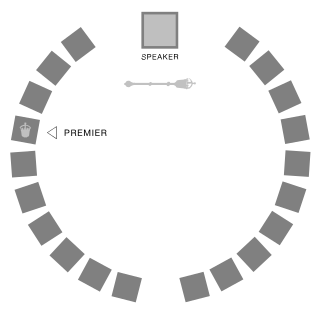Devolution is the statutory delegation of powers from the central government of a sovereign state to govern at a subnational level, such as a regional or local level. It is a form of administrative decentralization. Devolved territories have the power to make legislation relevant to the area.
The Nunavut general election, 2004 was the second general election held in the Canadian territory. It was held on February 16, 2004, to elect the 19 members of the 2nd Legislative Assembly of Nunavut.

The Yukon Legislative Assembly is the legislative assembly for Yukon, Canada. The Yukon Legislative Assembly is the only legislature in Canada's three federal territories which is organized along political party lines. In Nunavut and the Northwest Territories, the legislative assemblies are instead elected on a non-partisan consensus government model.

Calgary was a provincial electoral district in Alberta, Canada that existed from 1905 to 1913 and was recreated from 1921 to 1959. The district returned from one to six members to the Legislative Assembly of Alberta. The district largely encompassed the boundaries of the City of Calgary, and was revised accordingly as the city grew.
Cardston was a provincial electoral district in southern Alberta, Canada. The riding was created in when Alberta first became a province in 1905.

The history of Northwest Territories capital cities begins with the purchase of the Territories by Canada from the Hudson's Bay Company in 1869, and includes a varied and often difficult evolution. Northwest Territories is unique amongst the other provinces and territories of Canada in that it has had seven capital cities in its history. The territory has changed the seat of government for numerous reasons, including civil conflict, development of infrastructure, and a history of significant revisions to its territorial boundaries.
The Northwest Territories division plebiscite was a stand-alone territory wide plebiscite conducted on April 14, 1982. This was the first territory wide plebiscite conducted in Northwest Territories history. The results of the plebiscite would eventually lead to the creation of Nunavut, and spawn three other plebiscites during the creation process of the new territory.
A plebiscite on a capital city was held on 11 December 1995 in the area of the Northwest Territories that was to be split off into the new territory of Nunavut. Voters were given the options of either Iqaluit or Rankin Inlet. Iqaluit was chosen by 60% of voters.
Elections NWT is an independent, non-partisan public agency responsible for the administration of territorial general elections, by-elections, and plebiscites in accordance with the Elections and Plebiscites Act. Elections NWT is headed by the Chief Electoral Officer, an officer of the Legislative Assembly of the Northwest Territories.
James Arreak is a territorial and municipal level politician in Canada. He has served as a member of both the Nunavut and Northwest Territories legislatures.
Elections Nunavut is an independent agency that oversees elections and plebiscites in Nunavut, including:

The Northwest Territories is a territory in Northern Canada, specifically in Northwestern Canada between Yukon Territory and Nunavut including part of Victoria Island, Melville Island, and other islands on the western Arctic Archipelago. Originally a much wider territory enclosing most of central and northern Canada, the Northwest Territories was created in 1870 from the Hudson's Bay Company's holdings that were sold to Canada from 1869-1870. In addition, Alberta and Saskatchewan were formed from the territory in 1905. In 1999, it was divided again: the eastern portion became the new territory of Nunavut. Yellowknife stands as its largest city and capital. It has a population of 42,800 and has an area of 532,643 sq mi (1,379,540 km2). The current territory lies west of Nunavut, north of latitude 60° north, and east of Yukon.
Gooteleah "Goo" "Mosa" Arlooktoo was a Canadian politician and former cabinet minister from Northwest Territories, Canada. He briefly served as acting premier of the territory.
Titus Allooloo is a business man and former territorial level politician from Nunavut, Canada. He served as a member and cabinet Minister of the Northwest Territories Legislature through two terms from 1987 until 1995.
A plebiscite on the boundary between Northwest Territories and the new territory of Nunavut was held in the Northwest Territories on 4 May 1992. The proposed border was approved by 54% of voters. A second referendum later in the year gave the final approval to the creation of the new territory.
A referendum on the creation of the territory of Nunavut was held between 3 and 5 November 1992 in the territory set to become the new territory. It was approved by 69% of voters. On 25 May 1993 the Mulroney government and the TFN signed the Nunavut Agreement. On 10 June 1993 the federal Parliament passed two laws dividing the Northwest Territories and providing for the formation of Nunavut on 1 April 1999.






